Wettability and Spreading Behavior of Sn–Ti Alloys on Si3N4
Abstract
:1. Introduction
2. Experimental Materials and Methods
3. Results
3.1. Wetting Behavior of Sn-Ti on Si3N4
3.2. Interfacial Microstructure of Sn-xTi/Si3N4 Wetting System
4. Discussion
4.1. Thermodynamic Analysis of Reactions between Sn-xTi and Si3N4
4.2. Spreading Kinetics and Mechanism
5. Conclusions
- 1.
- As Ti element is added, the contact angle of Sn on Si3N4 is dramatically decreased due to the metallic TiN and Ti5Si3 phases formed by reactions between Ti and Si3N4. With a higher Ti concentration, the reaction layer thickens and the final contact angle becomes lower. The lowest value θ = 6o was achieved in Sn-2Ti system. However, the final contact increases when 2.5Ti is added, resulting from the resistance caused by large Ti6Sn5 bulks.
- 2.
- The Ti element reacts with Si3N4 to form the TiN phase, releasing free Si, then the free Si element reacts with active Ti to generate the Ti5Si3 layer. As the addition of Ti increases, coverage of the reaction products on substrates increases gradually. When Ti content is lower than 2.0 wt. %, the discontinuous reaction layers beneath the droplets and the richness of reaction products near the triple line can be observed. The continuous reaction layers are obtained in Sn-2.0Ti and Sn-2.5Ti/Si3N4 wetting systems.
- 3.
- The whole wetting process can be split into two different stages: (i) rapid-spreading and (ii) sluggish-decrease. In the first stage, adequate active Ti diffuses towards the triple line and react with the Si3N4 substrate. Consequently, a fast-spreading process of melted Sn droplet on Si3N4 is obtained. During the following isothermal stage, sufficient active Ti element is consumed by the interfacial reaction and the triple line keeps moving. The lower Ti content and the further distance from the middle area to the edge hinder the diffusion of Ti towards the triple line. Therefore, the sluggish spreading stage is observed because of the weaker reaction.
- 4.
- Temperature presents an immense effect on the spreading process. The spreading kinetic constant increases from 2.3 × 10−3 to 7.8 × 10−2 with isothermal temperature changing from 1223 K to 1273 K. The spreading activation energy for the Sn-Ti alloy on Si3N4 is calculated to be 395 kJ/mol. This work can provide a reference for the addition of active Ti elements during the metallization and brazing process of Si3N4 ceramics with other metals, which can be beneficial for the performance of the metal/ceramic joints.
Author Contributions
Funding
Institutional Review Board Statement
Informed Consent Statement
Data Availability Statement
Acknowledgments
Conflicts of Interest
References
- Song, Y.; Liu, D.; Jin, G.; Zhu, H.; Chen, N.; Hu, S.; Song, X.; Cao, J. Fabrication of Si3N4/Cu direct-bonded heterogeneous interface assisted by laser irradiation. J. Mater. Sci. Technol. 2022, 99, 169–177. [Google Scholar] [CrossRef]
- Gui, X.; Zhang, M.; Xu, P.; Liu, G.; Guo, Q.; Zhang, X.; Meng, H.; Qiao, G. Experimental and theoretical study on air reaction wetting and brazing of Si3N4 ceramic by Ag-CuO filler metal: Performance and interfacial behavior. J. Eur. Ceram. Soc. 2022, 42, 432–441. [Google Scholar] [CrossRef]
- Wang, R.; Zhang, C.; Li, D.; Xie, Z.; Zhang, Y.; Lu, X. Wettability and interfacial reaction mechanism between Ag–Cu alloy and Si3N4 ceramics in air atmosphere. Ceram. Int. 2021, 47, 33078–33088. [Google Scholar] [CrossRef]
- He, Y.M.; Zhang, J.; Liu, C.F.; Sun, Y. Microstructure and mechanical properties of Si3N4/Si3N4 joint brazed with Ag–Cu–Ti+SiCp composite filler. Mater. Sci. Eng. A 2010, 527, 2819–2825. [Google Scholar] [CrossRef]
- Fei, S.O.; Tobe, H.; Fujii, G.; Sato, E. Microstructural evolution and mechanical characterization of Nb-interlayer-inserted Ti–6Al–4V/Si3N4 joints brazed with AuNiTi filler. Mater. Sci. Eng. A 2020, 778, 139093. [Google Scholar]
- Zhao, Y.X.; Wang, M.R.; Cao, J.; Song, X.G.; Tang, D.Y.; Feng, J.C. Brazing TC4 alloy to Si3N4 ceramic using nano-Si3N4 reinforced AgCu composite filler. Mater. Des. 2015, 76, 40–46. [Google Scholar] [CrossRef]
- Wang, W.; Yao, D.; Chen, H.; Xia, Y.; Zuo, K.; Yin, J.; Liang, H.; Zeng, Y.P. ZrSi2–MgO as novel additives for high thermal conductivity of β-Si3N4 ceramics. J. Am. Ceram. Soc. 2020, 103, 2090–2100. [Google Scholar] [CrossRef]
- Liu, C.F.; Zhang, J.; Zhou, Y.; Meng, Q.C.; Naka, M. Effect of Ti content on microstructure and strength of Si3N4/Si3N4 joints brazed with Cu–Pd–Ti filler metals. Mater. Sci. Eng. A 2008, 491, 483–487. [Google Scholar] [CrossRef]
- Wang, X.; Dong, D.; Yang, X.; Huang, P.; Shi, K.; Ma, T.; Zhu, D.; Liu, L. Microstructure and Shear Strength of Brazing High Entropy TiZrHfNbMo Alloy and Si3N4 Ceramics Joints. Crystals 2021, 11, 472. [Google Scholar] [CrossRef]
- Elsawy, A.; Fahmy, M. Brazing of Si3N4 ceramic to copper. J. Mater. Process. Technol. 1998, 77, 266–272. [Google Scholar] [CrossRef]
- Yang, H.; Si, X.; Li, C.; Cao, J. Reactive Air Brazing of TiAl Alloy Using Ag-CuO: Microstructure and Joint Properties. Crystals 2021, 11, 1496. [Google Scholar] [CrossRef]
- Zhou, B.; Li, T.; Zhang, H.; Hou, J. Interface Behavior of Brazing between Zr-Cu Filler Metal and SiC Ceramic. Crystals 2021, 11, 727. [Google Scholar] [CrossRef]
- Fu, W.; Song, X.G.; Zhao, Y.X.; Cao, J.; Feng, J.C.; Jin, C.; Wang, G.D. Effect of Ti content on the wetting behavior of Sn0.3Ag0.7Cu/AlN system. Mater. Des. 2017, 115, 1–7. [Google Scholar] [CrossRef]
- Guo, M.; Fan, Z.; Fu, W.; Wang, Q.; Hu, S.; Song, X. Effect of Cr content on the wetting behavior of Cu–Cr/SiC system. Vacuum 2021, 194, 110591. [Google Scholar] [CrossRef]
- Ceccone, G.; Nicholas, M.; Peteves, S.; Kodentsov, A.; Kivilahti, J.; Van Loo, F. The brazing of Si3N4 with Ni-Cr-Si alloys. J. Eur. Ceram. Soc. 1995, 15, 563–572. [Google Scholar] [CrossRef] [Green Version]
- Fan, Z.; Guo, M.; Fu, W.; Xue, Y.; Hu, S.; Song, X. Wettability and spreading behavior of Sn–Cr alloys on SiC. Mater. Chem. Phys. 2021, 272, 124979. [Google Scholar] [CrossRef]
- Simhan, D.R.; Ghosh, A. Vacuum brazing of cubic boron nitride to medium carbon steel with Zr added passive and Ti activated eutectic Ag-Cu alloys. Ceram. Int. 2018, 44, 4891–4899. [Google Scholar] [CrossRef]
- Fu, W.; Passerone, A.; Bian, H.; Hu, S.; Zhao, Y.; Song, X.; Wang, M.; Valenza, F. Wetting and interfacial behavior of Sn–Ti alloys on zirconia. J. Mater. Sci. 2018, 54, 812–822. [Google Scholar] [CrossRef]
- Lee, H.K.; Lee, J.Y. A study of the wetting, microstructure and bond strength in brazing SiC by Cu-X (X = Ti, V, Nb, Cr) alloys. J. Mater. Sci. 1996, 31, 4133–4140. [Google Scholar] [CrossRef]
- Yang, J.; Huang, J.; Ye, Z.; Chen, S.; Ji, R.; Zhao, Y. Influence of interfacial reaction on reactive wettability of molten Ag-Cu-X wt.%Ti filler metal on SiC ceramic substrate and mechanism analysis. Appl. Surf. Sci. 2018, 436, 768–778. [Google Scholar] [CrossRef]
- Song, X.; Passerone, A.; Fu, W.; Hu, S.; Niu, C.; Zhao, Y.; Wang, M.; Valenza, F. Wetting and spreading behavior of Sn–Ti alloys on SiC. Materialia 2018, 3, 57–63. [Google Scholar] [CrossRef]
- Luz, A.P.; Ribeiro, S. Wetting behaviour of silicon nitride ceramics by Ti–Cu alloys. Ceram. Int. 2008, 34, 305–309. [Google Scholar] [CrossRef]
- Song, X.; Zhao, Y.; Hu, S.; Cao, J.; Fu, W.; Feng, J. Wetting of AgCu-Ti filler on porous Si3N4 ceramic and brazing of the ceramic to TiAl alloy. Ceram. Int. 2018, 44, 4622–4629. [Google Scholar] [CrossRef]
- Nomura, M.; Iwamoto, C.; Tanaka, S.I. Nanostructure of wetting triple line in a Ag–Cu–Ti/Si3N4 reactive system. Acta Mater. 1999, 47, 407–413. [Google Scholar] [CrossRef]
- Liggieri, L.; Passerone, A. An automatic technique for measuring the surface tension of liquid metals. High Temp. Technol. 1989, 7, 82–86. [Google Scholar] [CrossRef]
- Blugan, G.; Janczak-Rusch, J.; Kuebler, J. Properties and fractography of Si3N4/TiN ceramic joined to steel with active single layer and double layer braze filler alloys. Acta Mater. 2004, 52, 4579–4588. [Google Scholar] [CrossRef]
- Kritsalis, P.; Drevet, B.; Valignat, N.; Eustathopoulos, N. Wetting transitions in reactive metal/oxide systems. Scr. Metall. Mater. 1994, 30, 1127–1132. [Google Scholar] [CrossRef]
- Zhang, J.; Liu, J.; Wang, T. Microstructure and brazing mechanism of porous Si3N4/Invar joint brazed with Ag-Cu-Ti/Cu/Ag-Cu multi-layered filler. J. Mater. Sci. Technol. 2018, 34, 713–719. [Google Scholar] [CrossRef]
- Barin, I.; Platzki, G. Thermochemical Data of Pure Substances; Wiley Online Library: Hoboken, NJ, USA, 1989; Volume 304. [Google Scholar]
- Yang, L.; Shen, P.; Lin, Q.; Qiu, F.; Jiang, Q. Effect of Cr on the wetting in Cu/graphite system. Appl. Surf. Sci. 2011, 257, 6276–6281. [Google Scholar] [CrossRef]
- Eustathopoulos, N.; Nicholas, M.G.; Drevet, B. Wettability at High Temperatures; Elsevier: Amsterdam, The Netherlands, 1999. [Google Scholar]
- Okamoto, H. Sn-Ti (tin-titanium). J. Phase Equilibria Diffus. 2010, 31, 202–203. [Google Scholar] [CrossRef]
- Zou, J.; Jiang, Z.; Zhao, Q.; Chen, Z. Brazing of Si3N4 with amorphous Ti40Zr25Ni15Cu20 filler. Mater. Sci. Eng. A 2009, 507, 155–160. [Google Scholar] [CrossRef]
- Fu, W.; Song, X.; Tian, R.; Lei, Y.; Long, W.; Zhong, S.; Feng, J. Wettability and joining of SiC by Sn-Ti: Microstructure and mechanical properties. J. Mater. Sci. Technol. 2020, 40, 15–23. [Google Scholar] [CrossRef]
- Gu, D.; Shen, Y.; Lu, Z. Preparation of TiN–Ti5Si3 in-situ composites by selective laser melting. Mater. Lett. 2009, 63, 1577–1579. [Google Scholar] [CrossRef]
- Cassie, A.B.D.; Baxter, S. Wettability of porous surfaces. Trans. Faraday Soc. 1944, 40, 546–551. [Google Scholar] [CrossRef]
- Fu, W.; Hu, S.; Song, X.; Li, J.; Cao, J.; Feng, J.; Wang, G. Wettability and bonding of graphite by Sn0.3Ag0.7Cu-Ti alloys. Carbon 2017, 121, 536–543. [Google Scholar] [CrossRef]
- Dezellus, O.; Hodaj, F.; Eustathopoulos, N. Chemical reaction-limited spreading: The triple line velocity versus contact angle relation. Acta Mater. 2002, 50, 4741–4753. [Google Scholar] [CrossRef]
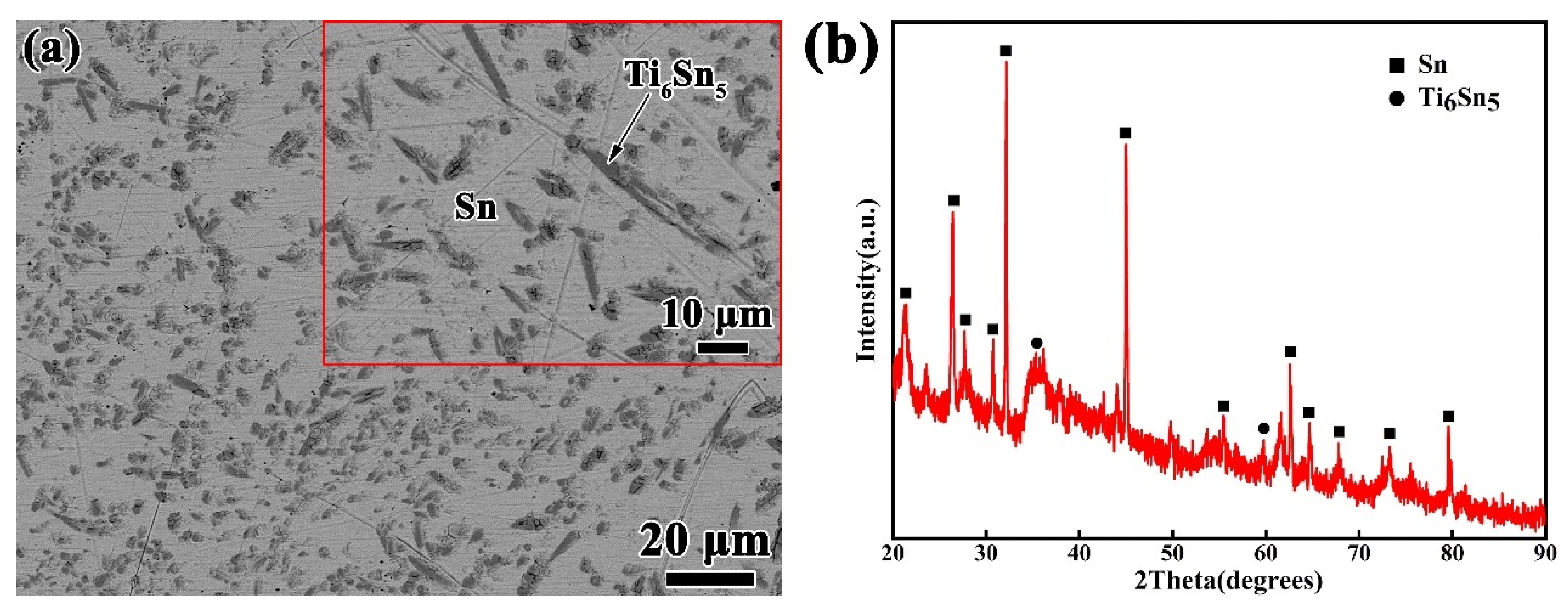

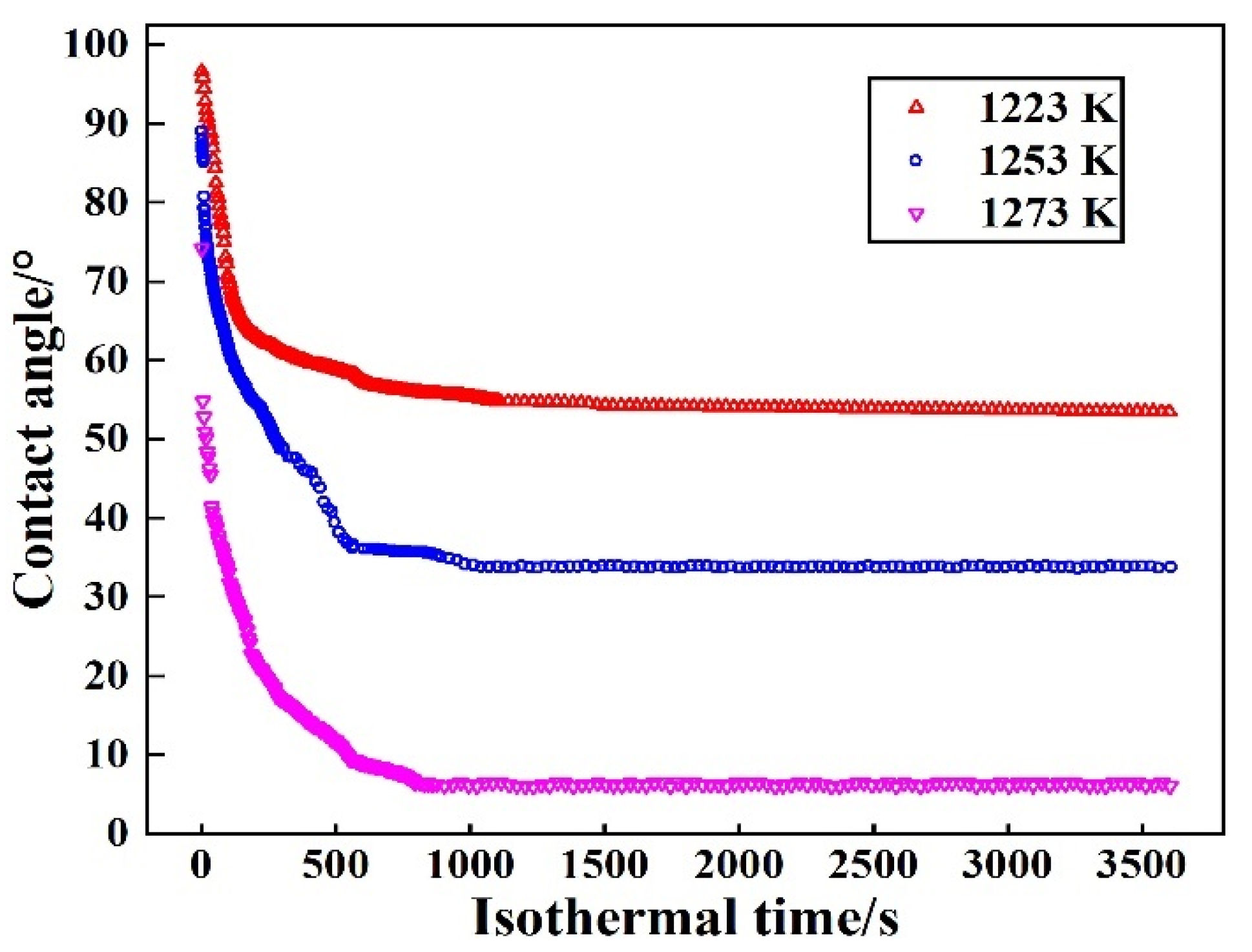
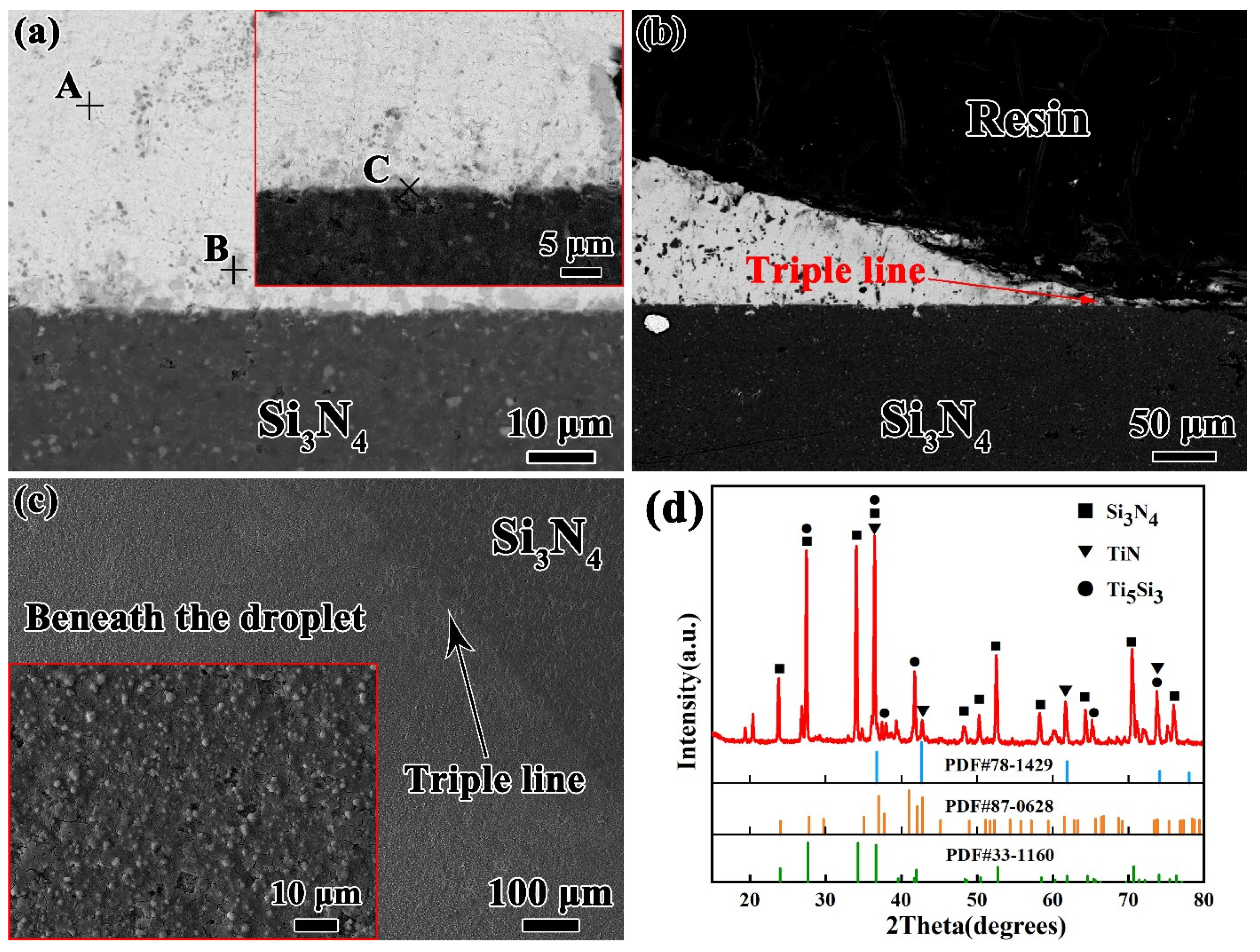


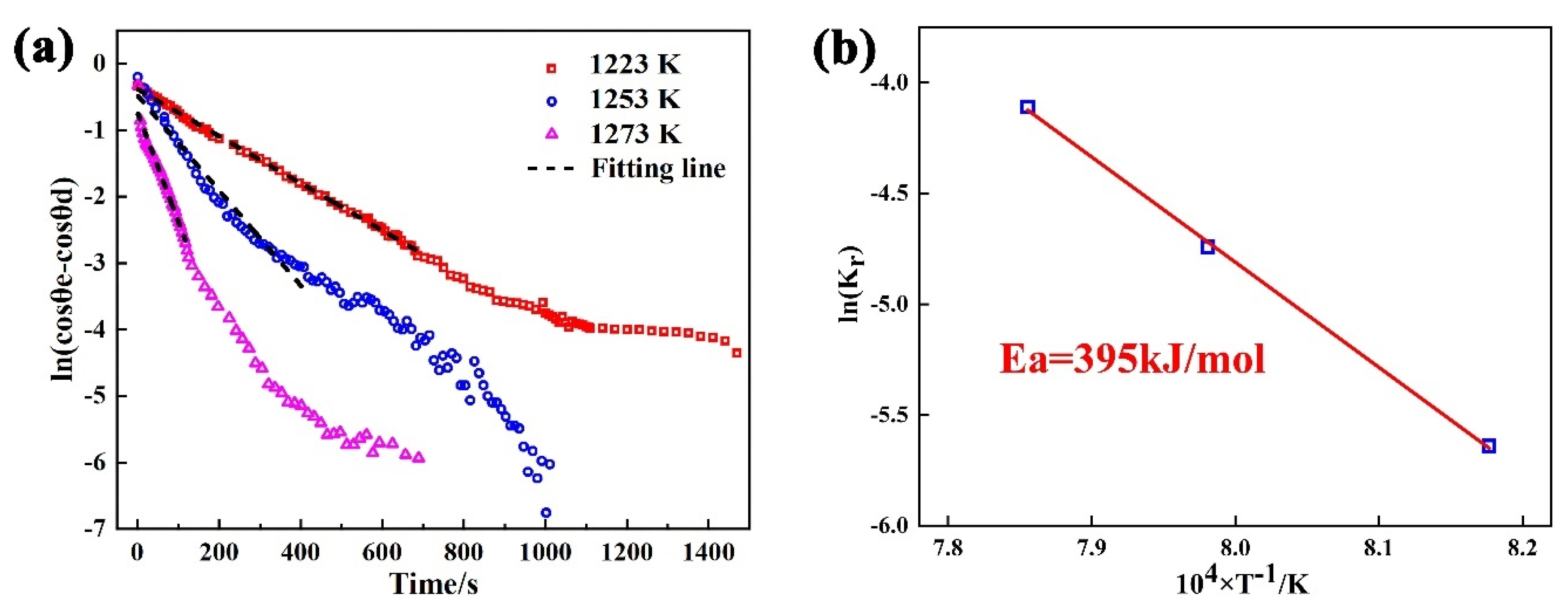
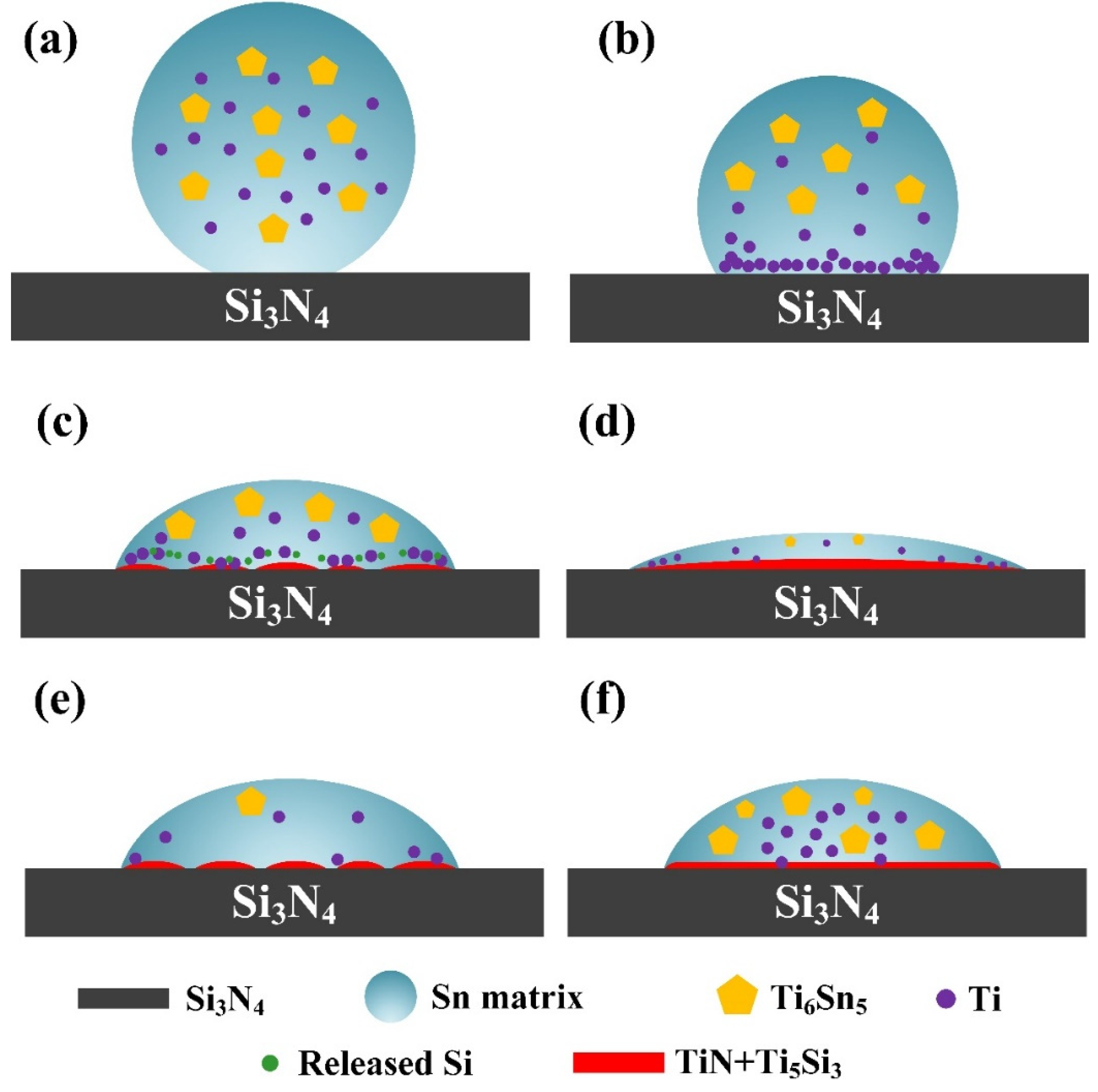
| Spot | Sn | Ti | Si | N | Possible Phases |
|---|---|---|---|---|---|
| A (in Figure 4) | 82.06 | 0.62 | 2.42 | 14.90 | β-Sn |
| B (in Figure 4) | 28.51 | 54.56 | 3.04 | 13.89 | Ti6Sn5 |
| C (in Figure 4) | 12.3 | 25.8 | 53.4 | 11.5 | Ti-Si + Ti-N |
| D (in Figure 5) | 39.6 | 53.9 | 6.5 | - | Ti6Sn5 |
| Parameters | Sn-xTi/Si3N4 Systems | ||||
|---|---|---|---|---|---|
| Ti content in weight (wt.%) | 0.5 | 1.0 | 1.5 | 2.0 | 2.5 |
| Ti content in atomic (at.%) | 1.13 | 2.24 | 3.34 | 4.43 | 5.49 |
| Normal concentration of Ti in Sn-Ti melt (at. %) | 1.13 | 2.24 | 3.34 | 4.43 | 5.49 |
| Activity of Ti | 12.3 | 24.57 | 36.64 | 48.60 | 60.23 |
| ΔGr (1) (kJ/mol) | −588.66 | −595.98 | −600.21 | −603.2 | −605.47 |
| ΔGr (2) (kJ/mol) | −60.28 | −67.6 | −71.83 | −74.82 | −77.09 |
Publisher’s Note: MDPI stays neutral with regard to jurisdictional claims in published maps and institutional affiliations. |
© 2022 by the authors. Licensee MDPI, Basel, Switzerland. This article is an open access article distributed under the terms and conditions of the Creative Commons Attribution (CC BY) license (https://creativecommons.org/licenses/by/4.0/).
Share and Cite
Wang, H.; Fu, W.; Xue, Y.; Huo, S.; Guo, M.; Hu, S.; Song, X. Wettability and Spreading Behavior of Sn–Ti Alloys on Si3N4. Crystals 2022, 12, 921. https://doi.org/10.3390/cryst12070921
Wang H, Fu W, Xue Y, Huo S, Guo M, Hu S, Song X. Wettability and Spreading Behavior of Sn–Ti Alloys on Si3N4. Crystals. 2022; 12(7):921. https://doi.org/10.3390/cryst12070921
Chicago/Turabian StyleWang, Huaijin, Wei Fu, Yidi Xue, Shihui Huo, Min Guo, Shengpeng Hu, and Xiaoguo Song. 2022. "Wettability and Spreading Behavior of Sn–Ti Alloys on Si3N4" Crystals 12, no. 7: 921. https://doi.org/10.3390/cryst12070921
APA StyleWang, H., Fu, W., Xue, Y., Huo, S., Guo, M., Hu, S., & Song, X. (2022). Wettability and Spreading Behavior of Sn–Ti Alloys on Si3N4. Crystals, 12(7), 921. https://doi.org/10.3390/cryst12070921









